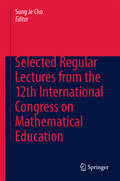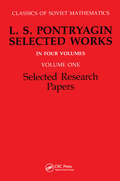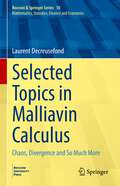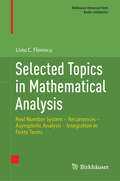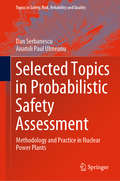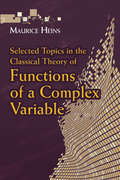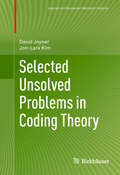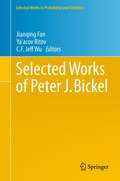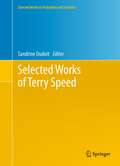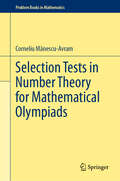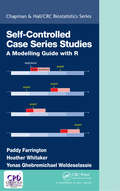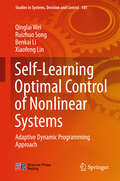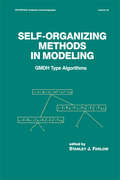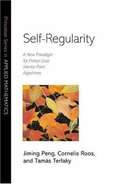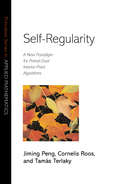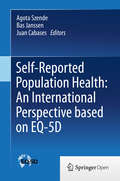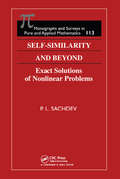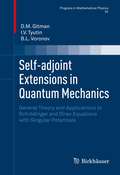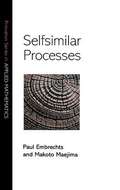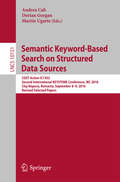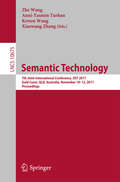- Table View
- List View
Selected Regular Lectures from the 12th International Congress on Mathematical Education
by Sung Je ChoThis book comprises the full selected Regular Lectures from the Proceedings of the 12th International Congress on Mathematical Education (ICME-12), which was held at COEX in Seoul, Korea, from July 8th to 15th, 2012. ICME-12 brought together 4700 experts from 100 countries, working to understand all of the intellectual and attitudinal challenges in the subject of mathematics education as a multidisciplinary research and practice. These selected Regular Lectures present the work of fifty-one prominent mathematics educators from all over the globe. The Lectures cover a wide spectrum of topics, themes and issues and aim to give direction to future research towards educational improvement in the teaching and learning of mathematics education. This book is of particular interest to researchers, teachers and curriculum developers in mathematics education.
Selected Research Papers: L.S Pontryagin Select Works Volume 1
by R. V. GamkrelidzeAmong the finest achievements in modern mathematics are two of L.S. Pontryagin's most notable contributions: Pontryagin duality and his general theory of characters of a locally compact commutative group. This book, the first in a four-volume set, contains the most important papers of this eminent mathematician, those which have influenced many generations of mathematicians worldwide. They chronicle the development of his work in many areas, from his early efforts in homology groups, duality theorems, and dimension theory to his later achievements in homotopic topology and optimal control theory. On 3 September 1983 Lev Semenovich Pontryagin was seventy-five. To mark this important event in the life of this outstanding contemporary mathematician we are beginning the publication of his scientific works in four volumes, according to a decision taken by the Mathematics Division of the USSR Academy of Sciences. The first volume contains the most important mathematical papers of L. S. Pontryagin and also includes a bibliography of his basic scientific works, the second is his well-known monograph Topological Groups, the third comprises two monographs, Foundations of Algebraic Topology and Smooth Manifolds and Their Applications in Homotopy Theory, and the fourth is a revised edition of The Mathematical Theory of Optimal Processes by L. S. Pontryagin, V. G. Boltyanskii, R. V. Gamkrelidze, and E. F. Mishchenko.
Selected Special Functions for Fundamental Physics (SpringerBriefs in Physics)
by Valeriya Akhmedova Emil T. AkhmedovThis book presents calculation methods that are used in both mathematical and theoretical physics. These methods will allow readers to work with selected special functions and more generally with differential equations, which are the most frequently used in quantum mechanics, theory of relativity and quantum field theory. The authors explain various approximation methods used to solve differential equations and to estimate integrals. They also address the basics of the relations between differential equations, special functions and representation theory of some of the simplest algebras on the one hand, and fundamental physics on the other. Based on a seminar for graduate physics students, the book offers a compact and quick way to learn about special functions. To gain the most from it, readers should be familiar with the basics of calculus, linear algebra, and complex analysis, as well as the basic methods used to solve differential equations and calculate integrals.
Selected Topics in Malliavin Calculus: Chaos, Divergence and So Much More (Bocconi And Springer Ser. #10)
by Laurent DecreusefondThis book is not a research monograph about Malliavin calculus with the latest results and the most sophisticated proofs. It does not contain all the results which are known even for the basic subjects which are addressed here. The goal was to give the largest possible variety of proof techniques. For instance, we did not focus on the proof of concentration inequality for functionals of the Brownian motion, as it closely follows the lines of the analog result for Poisson functionals. This book grew from the graduate courses I gave at Paris-Sorbonne and Paris-Saclay universities, during the last few years. It is supposed to be as accessible as possible for students who have knowledge of Itô calculus and some rudiments of functional analysis.
Selected Topics in Mathematical Analysis: Real Number System – Recurrences – Asymptotic Analysis – Integration in Finite Terms (Birkhäuser Advanced Texts Basler Lehrbücher)
by Liviu C. FlorescuThis book presents four topics related to undergraduate courses, typically not covered in standard lectures. Written in a clear and careful style, these four “pearls” aim at complementing and deepening the knowledge of students and instructors by presenting a variety of techniques and useful methods. The first chapter provides a detailed discussion of real numbers, the foundation of any mathematical construction. Chapter two of the book is dedicated to the study of sequences defined by recurrence relations. The third chapter explores certain problems in asymptotic analysis, and the final chapter of the book discusses mathematical results related to “Integration in Finite Terms”. Each chapter of the book is accompanied by its respective bibliography. The book is intended for readers with a level of maturity typically attained after completing a bachelor’s degree in mathematics.
Selected Topics in Probabilistic Safety Assessment: Methodology and Practice in Nuclear Power Plants (Topics in Safety, Risk, Reliability and Quality #38)
by Dan Serbanescu Anatoli Paul UlmeanuProbabilistic Safety Assessment (PSA) is a structured, comprehensive, and logical analysis method aimed at identifying and assessing risks in complex technological systems, such as the nuclear power plants. It is also known as probabilistic risk assessment – PRA. This book presents the theoretical basis to understand the numerous and complex aspects that are covered by PSA and it will help the reader to better understand and to effectively manage risks. The book provides PSA methods and techniques and it includes recommended procedures that are based on the experience of the authors and applicable to different levels and types of PSA that are used for nuclear power plants applications. It can be used as extra reading for PSA courses for practitioners and it provides quantitative risk methodology documentation for PSA.
Selected Topics in Statistical Inference: Theory and Applications
by Manisha Pal Bikas K. SinhaThis book focuses exclusively on the domain of parametric inference and that, too, from a reader’s perspective, i.e., covering only point estimation of parameter(s). It covers those topics in parametric inference which need clarity of exposure to students, researchers, and teachers alike; mere statements of theorems and proofs may not always reveal the inner beauty and significance of some aspects of inference. To ensure clarity, the book discusses the following topics at an advanced level—(1) sequential (unbiased) point estimation of ‘p’ and its functions; generalization to trinomial and tetranomial populations; (2) some aspects of the use of additional resources in finite population inference; (3) the concept of sufficiency vis-à-vis the notion of sufficient experiments and comparison of experiments; (4) estimation of the size of a finite population with special features; and (5) unbiased estimation of reliability in exponential samples and other settings. This book provides a platform for thought-provoking, creative, and challenging discussions on a variety of topics in statistical estimation theory, it is also ideal for research methodology course for statistics research scholars, and for clarification of basic ideas in topics discussed at basic/advanced levels.
Selected Topics in the Classical Theory of Functions of a Complex Variable (Dover Books on Mathematics)
by Maurice HeinsElegant and concise, this text is geared toward advanced undergraduate students acquainted with the theory of functions of a complex variable. The treatment presents such students with a number of important topics from the theory of analytic functions that may be addressed without erecting an elaborate superstructure. These include some of the theory's most celebrated results, which seldom find their way into a first course. After a series of preliminaries, the text discusses properties of meromorphic functions, the Picard theorem, and harmonic and subharmonic functions. Subsequent topics include applications and the boundary behavior of the Riemann mapping function for simply connected Jordan regions. The book concludes with a helpful Appendix containing information on Lebesgue's theorem and other topics.
Selected Unsolved Problems in Coding Theory (Applied and Numerical Harmonic Analysis)
by Jon-Lark Kim David JoynerUsing an original mode of presentation, and emphasizing the computational nature of the subject, this book explores a number of the unsolved problems that still exist in coding theory. A well-established and highly relevant branch of mathematics, the theory of error-correcting codes is concerned with reliably transmitting data over a 'noisy' channel. Despite frequent use in a range of contexts, the subject still contains interesting unsolved problems that have resisted solution by some of the most prominent mathematicians of recent decades. Employing Sage--a free open-source mathematics software system--to illustrate ideas, this book is intended for graduate students and researchers in algebraic coding theory. The work may be used as supplementary reading material in a graduate course on coding theory or for self-study.
Selected Works of Peter J. Bickel
by C.F. Jeff Wu Jianqing Fan Ya'Acov RitovThis volume presents selections of Peter J. Bickel's major papers, along with comments on their novelty and impact on the subsequent development of statistics as a discipline. Each of the eight parts concerns a particular area of research and provides new commentary by experts in the area. The parts range from Rank-Based Nonparametrics to Function Estimation and Bootstrap Resampling. Peter's amazing career encompasses the majority of statistical developments in the last half-century or about about half of the entire history of the systematic development of statistics. This volume shares insights on these exciting statistical developments with future generations of statisticians. The compilation of supporting material about Peter's life and work help readers understand the environment under which his research was conducted. The material will also inspire readers in their own research-based pursuits. This volume includes new photos of Peter Bickel, his biography, publication list, and a list of his students. These give the reader a more complete picture of Peter Bickel as a teacher, a friend, a colleague, and a family man.
Selected Works of Terry Speed
by Sandrine DudoitThe purpose of this volume is to provide an overview of Terry Speed's contributions to statistics and beyond. Each of the fifteen chapters concerns a particular area of research and consists of a commentary by a subject-matter expert and selection of representative papers. The chapters, organized more or less chronologically in terms of Terry's career, encompass a wide variety of mathematical and statistical domains, along with their application to biology and medicine. Accordingly, earlier chapters tend to be more theoretical, covering some algebra and probability theory, while later chapters concern more recent work in genetics and genomics. The chapters also span continents and generations, as they present research done over four decades, while crisscrossing the globe. The commentaries provide insight into Terry's contributions to a particular area of research, by summarizing his work and describing its historical and scientific context, motivation, and impact. In addition to shedding light on Terry's scientific achievements, the commentaries reveal endearing aspects of his personality, such as his intellectual curiosity, energy, humor, and generosity.
Selection Tests in Number Theory for Mathematical Olympiads (Problem Books in Mathematics)
by Corneliu Mănescu-AvramThis book gathers carefully chosen selection tests proposed to IMO (International Mathematical Olympiad) teams across many countries. Offering a blend of original solutions and adaptations by the author, this work is chronologically organized and provides a unique insight into the evolution of this mathematical contest. The proposed problems touch on topics such as the Chinese remainder theorem, Diophantine equations, Fermat's theorem, Euler's theorem, perfect squares, sequences of integers, and Pythagorean triples, to name a few. A meticulously crafted index helps the reader navigate through the topics with ease. This book serves as an invaluable preparation tool for both aspiring students and those passionate about mathematics alike.
Self-Controlled Case Series Studies: A Modelling Guide with R (Chapman & Hall/CRC Biostatistics Series)
by Paddy Farrington Heather Whitaker Yonas Ghebremichael WeldeselassieSelf-Controlled Case Series Studies: A Modelling Guide with R provides the first comprehensive account of the self-controlled case series (SCCS) method, a statistical technique for investigating associations between outcome events and time-varying exposures. The method only requires information from individuals who have experienced the event of interest, and automatically controls for multiplicative time-invariant confounders, even when these are unmeasured or unknown. It is increasingly being used in epidemiology, most frequently to study the safety of vaccines and pharmaceutical drugs. Key features of the book include: A thorough yet accessible description of the SCCS method, with mathematical details provided in separate starred sections. Comprehensive discussion of assumptions and how they may be verified. A detailed account of different SCCS models, extensions of the SCCS method, and the design of SCCS studies. Extensive practical illustrations and worked examples from epidemiology. Full computer code from the associated R package SCCS, which includes all the data sets used in the book. The book is aimed at a broad range of readers, including epidemiologists and medical statisticians who wish to use the SCCS method, and also researchers with an interest in statistical methodology. The three authors have been closely involved with the inception, development, popularisation and programming of the SCCS method.
Self-Learning Optimal Control of Nonlinear Systems
by Qinglai Wei Ruizhuo Song Benkai Li Xiaofeng LinThis book presents a class of novel, self-learning, optimal control schemes based on adaptive dynamic programming techniques, which quantitatively obtain the optimal control schemes of the systems. It analyzes the properties identified by the programming methods, including the convergence of the iterative value functions and the stability of the system under iterative control laws, helping to guarantee the effectiveness of the methods developed. When the system model is known, self-learning optimal control is designed on the basis of the system model; when the system model is not known, adaptive dynamic programming is implemented according to the system data, effectively making the performance of the system converge to the optimum. With various real-world examples to complement and substantiate the mathematical analysis, the book is a valuable guide for engineers, researchers, and students in control science and engineering.
Self-Organizing Methods in Modeling: GMDH Type Algorithms
by Stanley J. FarlowThis book introduces English-speaking people the basic group method of data handling algorithm. It could be used as a reference source for researchers or as a textbook for specialized courses and seminars in modeling, applied mathematics, and applied statistics.
Self-Regularity
by Tamás Terlaky Jiming Peng Cornelis RoosResearch on interior-point methods (IPMs) has dominated the field of mathematical programming for the last two decades. Two contrasting approaches in the analysis and implementation of IPMs are the so-called small-update and large-update methods, although, until now, there has been a notorious gap between the theory and practical performance of these two strategies. This book comes close to bridging that gap, presenting a new framework for the theory of primal-dual IPMs based on the notion of the self-regularity of a function. The authors deal with linear optimization, nonlinear complementarity problems, semidefinite optimization, and second-order conic optimization problems. The framework also covers large classes of linear complementarity problems and convex optimization. The algorithm considered can be interpreted as a path-following method or a potential reduction method. Starting from a primal-dual strictly feasible point, the algorithm chooses a search direction defined by some Newton-type system derived from the self-regular proximity. The iterate is then updated, with the iterates staying in a certain neighborhood of the central path until an approximate solution to the problem is found. By extensively exploring some intriguing properties of self-regular functions, the authors establish that the complexity of large-update IPMs can come arbitrarily close to the best known iteration bounds of IPMs. Researchers and postgraduate students in all areas of linear and nonlinear optimization will find this book an important and invaluable aid to their work.
Self-Regularity: A New Paradigm for Primal-Dual Interior-Point Algorithms (Princeton Series in Applied Mathematics #22)
by Tamás Terlaky Jiming Peng Cornelis RoosResearch on interior-point methods (IPMs) has dominated the field of mathematical programming for the last two decades. Two contrasting approaches in the analysis and implementation of IPMs are the so-called small-update and large-update methods, although, until now, there has been a notorious gap between the theory and practical performance of these two strategies. This book comes close to bridging that gap, presenting a new framework for the theory of primal-dual IPMs based on the notion of the self-regularity of a function. The authors deal with linear optimization, nonlinear complementarity problems, semidefinite optimization, and second-order conic optimization problems. The framework also covers large classes of linear complementarity problems and convex optimization. The algorithm considered can be interpreted as a path-following method or a potential reduction method. Starting from a primal-dual strictly feasible point, the algorithm chooses a search direction defined by some Newton-type system derived from the self-regular proximity. The iterate is then updated, with the iterates staying in a certain neighborhood of the central path until an approximate solution to the problem is found. By extensively exploring some intriguing properties of self-regular functions, the authors establish that the complexity of large-update IPMs can come arbitrarily close to the best known iteration bounds of IPMs. Researchers and postgraduate students in all areas of linear and nonlinear optimization will find this book an important and invaluable aid to their work.
Self-Reported Population Health: An International Perspective based on EQ-5D
by Agota Szende Bas Janssen Juan CabasésThe EQ-5D instrument, as a standardized, cross-culturally validated measure of self-assessed health has a hugely important role in understanding population health within and across countries. Over the past two decades a wealth of international population health survey data have been accumulated by the EuroQol Group from research conducted in many countries across four continents. One of the success factors of the EQ-5D instruments has been the easy availability of national or international sets of EQ-5D data, as well as clear explanations and guidance for users. There is an unmet need to produce a comprehensive book that captures up-to-date and expanded information of EQ-5D self-reported health and index values. EQ-5D population norms and cross-country analyses are provided from representative national surveys of 20 countries and additional regional surveys. This book will be a must for those who believe that how people report and value health is very important.
Self-Similarity and Beyond: Exact Solutions of Nonlinear Problems (Monographs and Surveys in Pure and Applied Mathematics #113)
by P.L. SachdevNonlinearity plays a major role in the understanding of most physical, chemical, biological, and engineering sciences. Nonlinear problems fascinate scientists and engineers, but often elude exact treatment. However elusive they may be, the solutions do exist-if only one perseveres in seeking them out.Self-Similarity and Beyond presents
Self-adjoint Extensions in Quantum Mechanics
by I. V. Tyutin D. M. Gitman B. L. VoronovThis exposition is devoted to a consistent treatment of quantization problems, based on appealing to some nontrivial items of functional analysis concerning the theory of linear operators in Hilbert spaces. The authors begin by considering quantization problems in general, emphasizing the nontriviality of consistent operator construction by presenting paradoxes to the naive treatment. It then builds the necessary mathematical background following it by the theory of self-adjoint extensions. By considering several problems such as the one-dimensional Calogero problem, the Aharonov-Bohm problem, the problem of delta-like potentials and relativistic Coulomb problemIt then shows how quantization problems associated with correct definition of observables can be treated consistently for comparatively simple quantum-mechanical systems. In the end, related problems in quantum field theory are briefly introduced. This well-organized text is most suitable for students and post graduates interested in deepening their understanding of mathematical problems in quantum mechanics. However, scientists in mathematical and theoretical physics and mathematicians will also find it useful.
Selfsimilar Processes
by Paul Embrechts Makoto MaejimaThe modeling of stochastic dependence is fundamental for understanding random systems evolving in time. When measured through linear correlation, many of these systems exhibit a slow correlation decay--a phenomenon often referred to as long-memory or long-range dependence. An example of this is the absolute returns of equity data in finance. Selfsimilar stochastic processes (particularly fractional Brownian motion) have long been postulated as a means to model this behavior, and the concept of selfsimilarity for a stochastic process is now proving to be extraordinarily useful. Selfsimilarity translates into the equality in distribution between the process under a linear time change and the same process properly scaled in space, a simple scaling property that yields a remarkably rich theory with far-flung applications. After a short historical overview, this book describes the current state of knowledge about selfsimilar processes and their applications. Concepts, definitions and basic properties are emphasized, giving the reader a road map of the realm of selfsimilarity that allows for further exploration. Such topics as noncentral limit theory, long-range dependence, and operator selfsimilarity are covered alongside statistical estimation, simulation, sample path properties, and stochastic differential equations driven by selfsimilar processes. Numerous references point the reader to current applications. Though the text uses the mathematical language of the theory of stochastic processes, researchers and end-users from such diverse fields as mathematics, physics, biology, telecommunications, finance, econometrics, and environmental science will find it an ideal entry point for studying the already extensive theory and applications of selfsimilarity.
Selfsimilar Processes (Princeton Series in Applied Mathematics #7)
by Paul EmbrechtsThe modeling of stochastic dependence is fundamental for understanding random systems evolving in time. When measured through linear correlation, many of these systems exhibit a slow correlation decay--a phenomenon often referred to as long-memory or long-range dependence. An example of this is the absolute returns of equity data in finance. Selfsimilar stochastic processes (particularly fractional Brownian motion) have long been postulated as a means to model this behavior, and the concept of selfsimilarity for a stochastic process is now proving to be extraordinarily useful. Selfsimilarity translates into the equality in distribution between the process under a linear time change and the same process properly scaled in space, a simple scaling property that yields a remarkably rich theory with far-flung applications. After a short historical overview, this book describes the current state of knowledge about selfsimilar processes and their applications. Concepts, definitions and basic properties are emphasized, giving the reader a road map of the realm of selfsimilarity that allows for further exploration. Such topics as noncentral limit theory, long-range dependence, and operator selfsimilarity are covered alongside statistical estimation, simulation, sample path properties, and stochastic differential equations driven by selfsimilar processes. Numerous references point the reader to current applications. Though the text uses the mathematical language of the theory of stochastic processes, researchers and end-users from such diverse fields as mathematics, physics, biology, telecommunications, finance, econometrics, and environmental science will find it an ideal entry point for studying the already extensive theory and applications of selfsimilarity.
Semantic Intelligence: Select Proceedings of ISIC 2022 (Lecture Notes in Electrical Engineering #964)
by Sven Groppe Bharat K. Bhargava Sarika JainThis book constitutes refereed proceedings of the 2nd International Semantic Intelligence Conference (ISIC 2022). This book covers a wide range of topics, including semantic web engineering, ontology-based data access, multimodal and multilingual access, machine-to-machine communications and interoperability, knowledge extraction and ontology learning from the web, computational paradigms and computational intelligence, distributed and mobile systems, and many others. This book includes novel contributions and the latest developments from researchers across industry and academia. This book serves as a valuable reference resource for academics and researchers across the globe.
Semantic Keyword-Based Search on Structured Data Sources: COST Action IC1302 Second International KEYSTONE Conference, IKC 2016, Cluj-Napoca, Romania, September 8–9, 2016, Revised Selected Papers (Lecture Notes in Computer Science #10151)
by Andrea Calì Dorian Gorgan Martín UgarteThis book constitutes the thoroughly refereed post-conference proceedings of the Second COST Action IC1302 International KEYSTONE Conference on Semantic Keyword-Based Search on Structured Data Sources, IKC 2016, held in Cluj-Napoca, Romania, in September 2016. The 15 revised full papers and 2 invited papers are reviewed and selected from 18 initial submissions and cover the areas of keyword extraction, natural language searches, graph databases, information retrieval techniques for keyword search and document retrieval.
Semantic Technology: 7th Joint International Conference, JIST 2017, Gold Coast, QLD, Australia, November 10-12, 2017, Proceedings (Lecture Notes in Computer Science #10675)
by Zhe Wang Anni-Yasmin Turhan Kewen Wang Xiaowang ZhangThis book constitutes the thoroughly refereed proceedings of the 7th Joint International Semantic Technology Conference, JIST 2017, held in Goldcoast, QLD, Australia, in November 2017. The 19 full papers and 4 short papers presented were carefully reviewed and selected from 37 submissions. They present applications of semantic technologies, theoretical results, new algorithms and tools to facilitate the adoption of semantic technologies and are organized in topical sections on ontology and data management; ontology reasoning; linked data and query; information retrieval and knowledge discovery; knowledge graphs; and applications of semantic technologies.
